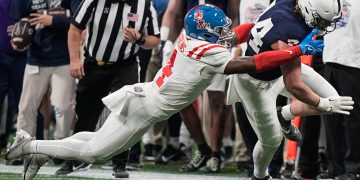
On the afternoon of July 20, nine Black student leaders — Nicholas Crasta, DeArrius Rhymes, Jailien Grant, Re’Kia Fairley, Candace Bolden, Amirah Lockhart, Asia Eichelberger, Chinwe Udemgba and Zuri Dixon Omere — met with Chancellor Glenn Boyce to discuss the future of minority representation and administrational transparency at the University of Mississippi.
Black Student Union (BSU) President Crasta said their requests included more minority representation on every university committee, the construction of a multicultural building on campus and targeted efforts to increase Black student recruitment and retention at the university.
“We, as Black students, represent 13% of the university, and that aligns with the population of the United States, but Mississippi is 37% Black,” Rhymes, the president of Men of Excellence, (MOX) said. “At the beginning and end of the day, we want to recruit and retain more Black students, so letting go of Confederate symbols, taking Lamar’s name off of Lamar Hall or Vardaman’s name off of Vardaman Hall and publicizing the good stuff we do at our university is what’s going to help with that.”
Boyce has now agreed to meet with this group of students on a monthly basis, and Crasta said he is looking forward to more concrete solutions coming from the meetings as they continue.
“It takes time to build a relationship,” Crasta said. “With everything that surrounded his name, it’s hard for a lot of students to trust Chancellor Boyce, but I see him taking the measures to try and build that trust back in the community.”
Between Boyce’s history of working at “segregation academies,” the murky process that led to his selection as chancellor and a publicized recruitment trip to Jackson that only included predominantly white private schools, Black students at the university have found more than one reason to criticize the chancellor.
“I know (some students) saw a different side of him based off of the way he was appointed, and nobody is happy about that,” Rhymes said. “But I can say we’re definitely giving him a chance. We don’t have a choice but to work with him, and why not work with him? We want progress as a community, not just the Black community but as a university.”
The nine Black student organization presidents originally demanded the July meeting because they were concerned that Boyce supported the glorification of the Confederate cemetery, but they broadened the meeting topics after the university confirmed on July 17 that it will not install headstones or other memorials in the cemetery.
Still, National Pan-Hellenic Council (NPHC) President Candace Bolden said that she and her fellow presidents would like the monument to be removed from campus altogether. However, since state legislators would have to change the law before that could happen, Bolden said removing the monument is going to take more than one generation of students.
“As leaders, we have to begin to build our legacy,” she said. “As younger people on campus who are leaders, it is important for us to educate and spend time with the people we’re mentoring so that the work we’re doing now can progress and be solidified into the fabric of what we are going to know this university for in the future.”
Bolden and the other presidents of Black student organizations agreed that they have noticed more of a dedication to diversity, inclusion and understanding of race at the University of Mississippi than they have ever seen before. However, Jalien Grant, the university’s chapter president of the National Association for the Advancement of Colored People (NAACP), said change at the university will not come from commitment alone.
“It doesn’t stop there. We have to hold these people accountable to more than just advocacy,” Grant said. “You have to bring more Black teachers to the school, hire more Black staff members (and) make more scholarships for Black students. Do more than just the performative acts of moving a statue.”



























